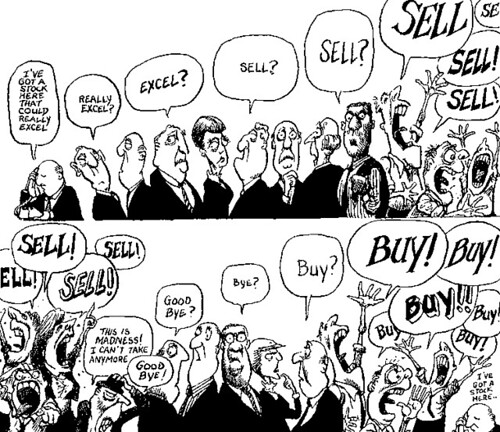What Is Economics Good For?
By ALEX ROSENBERG and TYLER CURTAIN Recent debates over who is most qualified to serve as the next chairman of the Federal Reserve have focused on more than just the candidates’ theory-driven economic expertise. They have touched on matters of personality and character as well. This is as it should be. Given the nature of economies, and our ability to understand them, the task of the Fed’s next leader will be more a matter of craft and wisdom than of science.When we put a satellite in orbit around Mars, we have the scientific knowledge that guarantees accuracy and precision in the prediction of its orbit. Achieving a comparable level of certainty about the outcomes of an economy is far dicier.
The fact that the discipline of economics hasn’t helped us improve our predictive abilities suggests it is still far from being a science, and may never be. Still, the misperceptions persist. A student who graduates with a degree in economics leaves college with a bachelor of science, but possesses nothing so firm as the student of the real world processes of chemistry or even agriculture.
Before the 1970s, the discussion of how to make economics a science was left mostly to economists. But like war, which is too important to be left to the generals, economics was too important to be left to the Nobel-winning members of the University of Chicago faculty. Over time, the question of why economics has not (yet) qualified as a science has become an obsession among theorists, including philosophers of science like us.
It’s easy to understand why economics might be mistaken for science. It uses quantitative expression in mathematics and the succinct statement of its theories in axioms and derived “theorems,” so economics looks a lot like the models of science we are familiar with from physics. Its approach to economic outcomes — determined from the choices of a large number of “atomic” individuals — recalls the way atomic theory explains chemical reactions. Economics employs partial differential equations like those in a Black-Scholes account of derivatives markets, equations that look remarkably like ones familiar from physics. The trouble with economics is that it lacks the most important of science’s characteristics — a record of improvement in predictive range and accuracy.
This is what makes economics a subject of special interest among philosophers of science. None of our models of science really fit economics at all.
The irony is that for a long time economists announced a semiofficial allegiance to Karl Popper’s demand for falsifiability as the litmus test for science, and adopted Milton Friedman’s thesis that the only thing that mattered in science was predictive power. Mr. Friedman was reacting to a criticism made by Marxist economists and historical economists that mathematical economics was useless because it made so many idealized assumptions about economic processes: perfect rationality, infinite divisibility of commodities, constant returns to scale, complete information, no price setting.
Mr. Friedman argued that false assumptions didn’t matter any more in economics than they did in physics. Like the “ideal gas,” “frictionless plane” and “center of gravity” in physics, idealizations in economics are both harmless and necessary. They are indispensable calculating devices and approximations that enable the economist to make predictions about markets, industries and economies the way they enable physicists to predict eclipses and tides, or prevent bridge collapses and power failures.
But economics has never been able to show the record of improvement in predictive successes that physical science has shown through its use of harmless idealizations. In fact, when it comes to economic theory’s track record, there isn’t much predictive success to speak of at all.
Moreover, many economists don’t seem troubled when they make predictions that go wrong. Readers of Paul Krugman and other like-minded commentators are familiar with their repeated complaints about the refusal of economists to revise their theories in the face of recalcitrant facts. Philosophers of science are puzzled by the same question. What is economics up to if it isn’t interested enough in predictive success to adjust its theories the way a science does when its predictions go wrong?
Unlike the physical world, the domain of economics includes a wide range of social “constructions” — institutions like markets and objects like currency and stock shares — that even when idealized don’t behave uniformly. They are made up of unrecognized but artificial conventions that people persistently change and even destroy in ways that no social scientist can really anticipate. We can exploit gravity, but we can’t change it or destroy it. No one can say the same for the socially constructed causes and effects of our choices that economics deals with.
Another factor economics has never been able to tame is science itself. These are the drivers of economic growth, the “creative destruction” of capitalism. But no one can predict the direction of scientific discovery and its technological application. That was Popper’s key insight. Philosophers and historians of science like Thomas S. Kuhn have helped us see why scientific paradigm shifts seem to come almost out of nowhere. As the rate of acceleration of innovation increases, the prospects of an economic theory that tames the economy’s most powerful forces must diminish — and with it, any hope of improvements in prediction declines as well.
SO if predictive power is not in the cards for economics, what is it good for?
Social and political philosophers have helped us answer this question, and so understand what economics is really all about. Since Hobbes, philosophers have been concerned about the design and management of institutions that will protect us from “the knave” within us all, those parts of our selves tempted to opportunism, free riding and generally avoiding the costs of civil life while securing its benefits. Hobbes and, later, Hume — along with modern philosophers like John Rawls and Robert Nozick — recognized that an economic approach had much to contribute to the design and creative management of such institutions. Fixing bad economic and political institutions (concentrations of power, collusions and monopolies), improving good ones (like the Fed’s open-market operations), designing new ones (like electromagnetic bandwidth auctions), in the private and public sectors, are all attainable tasks of economic theory.
Which brings us back to the Fed. An effective chair of the central bank will be one who understands that economics is not yet a science and may never be. At this point it is a craft, to be executed with wisdom, not algorithms, in the design and management of institutions. What made Ben S. Bernanke, the current chairman, successful was his willingness to use methods — like “quantitative easing,” buying bonds to lower long-term interest rates — that demanded a feeling for the economy, one that mere rational-expectations macroeconomics would have denied him.
For the foreseeable future economic theory should be understood more on the model of music theory than Newtonian theory. The Fed chairman must, like a first violinist tuning the orchestra, have the rare ear to fine-tune complexity (probably a Keynesian ability to fine-tune at that). Like musicians’, economists’ expertise is still a matter of craft. They must avoid the hubris of thinking their theory is perfectly suited to the task, while employing it wisely enough to produce some harmony amid the cacophony.



















